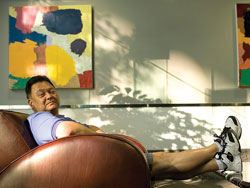“Most kids assumed I was Native American,” says TIM HOLM, “but no one really treated me differently.” In 1959, Holm was adopted from Korea at age 2. He grew up in small Oregon towns with a Korean adopted sister and Swedish-American parents. Today, he is president and treasurer of the Asian Adult Adoptees of Washington (AAAW) and treasurer of the Korean Identity Development Society (KIDS). “Korean families with kids who grew up here say, ‘Our kids are just like you,'” he says. “No, they’re nothing like me. Their parents are able to tell them about their history and culture. I’m physically Asian, but socially and culturally I’m white American.” The eventual identity questions are part of what led to Holm’s involvement with AAAW and the establishment of the U.S. International Korean Adoptee Association (IKAA), which has become an unprecedented network for adopted Koreans internationally. Holm and his wife also organize annual tours of Korea with adoptive families from around the country. A trip this summer will mark their 15th tour in 14 years, but Holm has been to Korea almost 50 times. “I look at my family and I know I won’t grow up to be 6-foot, blond, and blue-eyed. This gives adoptees something to look at and say, ‘Hey, I can grow up to be like somebody.'”
According to the Washington Association for Children and Parents (WACAP), more than 9,000 people in the state are international adoptees, predominantly from Korea, Russia, and China, but also from countries such as Kazakhstan and Thailand. This makes Washington about fourth in the country for international adoptees per capita. Local agencies such as WACAP help adopting parents with everything from initial paperwork to organizing regular get-togethers for the families they work with. Their most recent event at Seward Park last month brought out about 500 people. The agency has assisted in the placement of almost 9,000 children nationally, about half of whom were given homes in this area, and the employees are predominantly adoptees or adoptive parents themselves. “Typically, a child is adopted by a family that speaks only English,” says WACAP interim CEO Lillian Thogersen, who immigrated from Norway with her family when she was 3. “For me, the family and culture were the same, the people and food were the same, but for an adopted child, everything is different. In one sense, it is a much greater transition, but also children are so much more adaptable.” Thogersen has nine children, eight adopted—one came into her life at age 8 and two at 13, which is much older than the average adoptee of about 1 year or younger. She says that it only took six months for her 8-year-old to become fluent in English.
“In the Northwest, we’re lucky and privileged that we do have a diversity of ethnicities up here,” says Holm. “That’s not true in other places. My adopted friends who grew up in Iowa and Nebraska and Kansas get really jealous.”
And with identity groups such as local chapters of Families with Children From China (FCC), Families for Russian & Ukrainian Adoption (FRUA), and the Morning Star Korean Cultural Center in Lynnwood, resources for Northwest adoptees are healthy and growing as the adopted community matures.
“Adoptees are not just little children anymore,” says Holm. “That’s how you raise money, by showing pictures of orphans. But we’re just like anybody else. We’re adults, we’re family people, we’re business people. It’s important to say and do and speak on our own behalf.”






